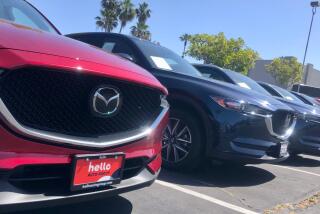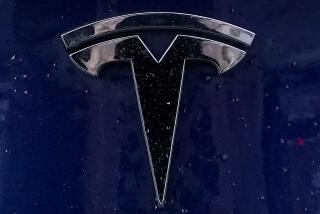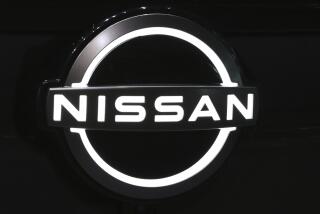Air Bags Are Not the Perfect Sentinel
Air bags are supposed to be silent sentinels that protect a car’s occupants, but some motorists are discovering that the computer-controlled pyrotechnic devices can play dirty tricks.
General Motors this month recalled 103,000 Cadillacs and 863,000 Cavaliers and Sunbirds after hundreds of drivers reported that their air-bag systems were deploying when there were no accidents.
As air bags become more prevalent, more and more drivers are complaining that the devices are oversensitive to encounters with bumps, potholes, curbs and other jarring experiences that are part of routine driving.
Take the example of Patty Skale of San Diego, who wrote to Your Wheels earlier this year about her 19-year-old son’s 1995 Mustang. While rounding a corner, her son hit a curb and both air bags triggered. Skale was told by her mechanic that it would cost $1,800 to replace the bags; when she tried to find a less expensive alternative, she discovered that nobody was willing to install salvage bags from a junkyard.
The National Highway Traffic Safety Administration has investigated reports of oversensitive deployment of air bags in vehicles manufactured by Chrysler, Mitsubishi, Subaru and Mazda. In all, NHTSA received more than 600 complaints of oversensitive deployments between 1994 and 1997.
*
In many cases, the problem of inadvertent air-bag deployment is far worse than just the cost. GM acknowledges that 39 occupants were injured in 70 reported cases of oversensitive deployments in Cadillacs. The Cavalier and Sunbird models had 231 instances of improper deployments that caused 91 injuries.
What kind of injuries? They range from minor cuts and bruises to broken arms. Arm and wrist injuries are not uncommon for drivers in air-bag deployments, because of how the steering wheel is grasped.
The issue raises the question of whether some bags are less effective or more dangerous than others. Federal officials say that they have no evidence of major performance discrepancies among bags.
“If we thought there were characteristics that defined one air bag as having risks and another as not having risks, we would be the first to announce that,” said Philip Recht, deputy administrator of NHTSA. “We have not seen this data so far.”
Software is at fault in many of the cases in which air bags pop on their own.
With the Cavalier and Sunbird, GM said, the algorithms (or software equations) that controlled the bags were flawed. As a result, the bags would deploy when the cars absorbed shocks to the floor, as in cases in which lumber or rocks were hit in the roadway, said GM spokesman Kyle Johnson. The company will reprogram the air-bag computers in the recalls.
The Cadillac problem was that the air-bag computer was unsealed and located on the floor, where it could become soaked if the windows were left down in a storm or a carwash. The solution is to install sealed computers.
Exactly when an air bag should trigger is quite complex, and not dependent simply on the speed of the crash, Johnson said. With the precise measurements of an accelerometer, a sensor that measures crash forces, a car’s computer can determine how metal is being crushed, the overall drop in speed and what kind of collision is occurring.
Federal standards do not dictate when an air bag should deploy--only that the system is supposed to protect a belted or unbelted standard male dummy in a 30-mph crash test, said Tim Hurd, a spokesman at NHTSA. It is left to manufacturers to decide whether the bags will deploy at crash speeds of 25 mph or lower.
Johnson said GM tries to strike a balance between protecting occupants in major accidents and subjecting them to the risk of injury if the air bags deploy in minor accidents.
“Air bags are powerful devices,” Johnson said.
Buyers have to take it as an article of faith that manufacturers’ software and sensors strike the correct balance. Proponents say that 2.4 million air bags have deployed in the last 10 years and saved more than 3,000 lives.
But oversensitive deployments remain a black eye for air bags. Controversy erupted last year when it was disclosed that air bags had killed 108 people, mainly children and small-stature adults, in low-speed collisions that otherwise would not have been fatal.
At the very least, it is now clear that air bags are not without both safety and financial risks.
*
Times staff writer Ralph Vartabedian cannot answer mail personally but will attempt to respond in this column to automotive questions of general interest. Do not telephone. Write to Your Wheels, 1875 I St. N.W., No. 1100, Washington, DC 20006.
Via e-mail: ralph.vartabedian@latimes.com.







